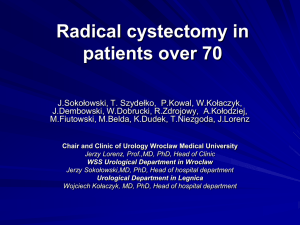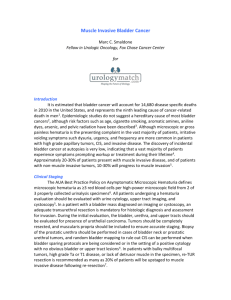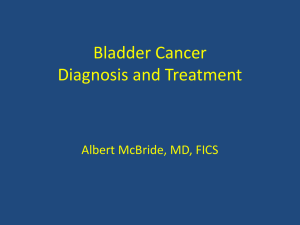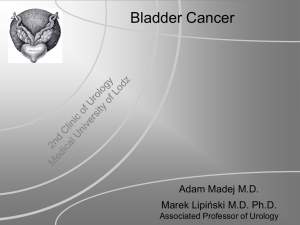Radical cystectomy and bladder-sparing treatments for
advertisement
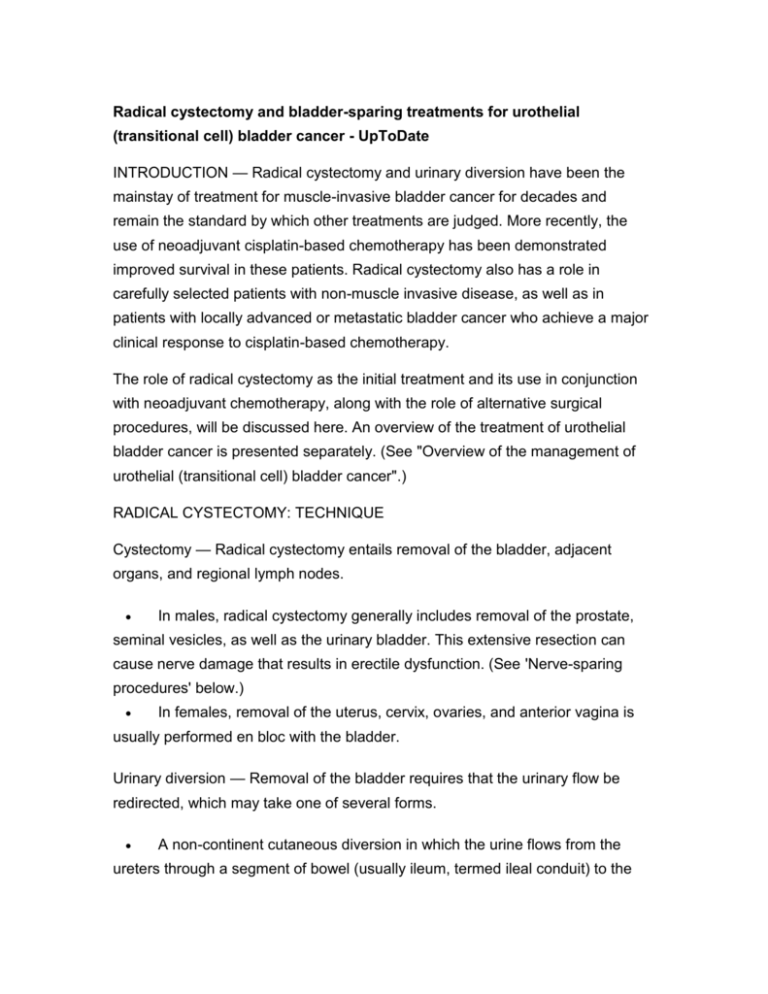
Radical cystectomy and bladder-sparing treatments for urothelial (transitional cell) bladder cancer - UpToDate INTRODUCTION — Radical cystectomy and urinary diversion have been the mainstay of treatment for muscle-invasive bladder cancer for decades and remain the standard by which other treatments are judged. More recently, the use of neoadjuvant cisplatin-based chemotherapy has been demonstrated improved survival in these patients. Radical cystectomy also has a role in carefully selected patients with non-muscle invasive disease, as well as in patients with locally advanced or metastatic bladder cancer who achieve a major clinical response to cisplatin-based chemotherapy. The role of radical cystectomy as the initial treatment and its use in conjunction with neoadjuvant chemotherapy, along with the role of alternative surgical procedures, will be discussed here. An overview of the treatment of urothelial bladder cancer is presented separately. (See "Overview of the management of urothelial (transitional cell) bladder cancer".) RADICAL CYSTECTOMY: TECHNIQUE Cystectomy — Radical cystectomy entails removal of the bladder, adjacent organs, and regional lymph nodes. In males, radical cystectomy generally includes removal of the prostate, seminal vesicles, as well as the urinary bladder. This extensive resection can cause nerve damage that results in erectile dysfunction. (See 'Nerve-sparing procedures' below.) In females, removal of the uterus, cervix, ovaries, and anterior vagina is usually performed en bloc with the bladder. Urinary diversion — Removal of the bladder requires that the urinary flow be redirected, which may take one of several forms. A non-continent cutaneous diversion in which the urine flows from the ureters through a segment of bowel (usually ileum, termed ileal conduit) to the skin surface as a stoma, where it is collected in an external bag or other appliance. A cutaneous continent reservoir may be constructed to avoid the need for an external appliance (usually using the right colon and terminal ileum). The patient self-catheterizes him or herself at regular intervals to empty the reservoir. For men and women wishing to avoid cutaneous urinary diversion, an orthotopic neobladder may be formed from a segment of bowel and attached to the urethra, enabling them to void through the urethra. Continent diversions can greatly improve patient quality of life and self-image and increase their acceptance of radical cystectomy. The choice of urinary diversion is based upon patient and surgeon preference and may be influenced by the extent of cancer and other patient-related factors. These options and the issues involved in choosing an approach to urinary diversion for an individual patient are discussed separately. (See "Urinary diversion and reconstruction following cystectomy".) Pelvic lymph node dissection — In patients who undergo radical cystectomy, the extent of pelvic lymph node dissection is defined anatomically and often measured by the total number of lymph nodes removed, is an important predictor of survival in those with both positive and negative lymph nodes [1-5]. The improved prognosis associated with increasing lymph node counts may be due to the resection of histopathologically occult nodal metastases [6] or it may be a surrogate for the quality of surgery. (See 'Prognosis' below.) Accumulating evidence suggests that the standard template for pelvic lymph node dissection (distal common iliac, obturator, hypogastric, and external iliac nodes) is inadequate. This was illustrated by a mapping study in which 290 patients had an extended lymphadenectomy with removal of all nodal regions distal to the aortic bifurcation and removal of retroperitoneal lymph nodes below the inferior mesenteric artery [7]. Positive lymph nodes were identified in 28 percent of cases, of which only 25 percent had positive nodes restricted to the standard template and 25 percent had involved nodes located outside, but not within, the standard template. Based upon these results, many centers have adopted an extended template dissection to include the presacral and common iliac lymph nodes to the aortic bifurcation and often more proximal to the origin of the inferior mesenteric artery, in addition to the pelvic lymph nodes distal to the common iliac bifurcation. Nerve-sparing procedures — Resection of the prostate and seminal vesicles in conjunction with cystectomy frequently results in damage to the neurovascular bundles, thus causing impotence. Men with good erectile function who desire to preserve their potency after radical cystectomy may be candidates for preservation of the cavernous nerves, similar to that performed during nervesparing radical prostatectomy. (See "Radical prostatectomy for localized prostate cancer".) Nerve-sparing cystectomy requires dissection close to the urinary bladder, exposing patients to the risks of positive soft tissue surgical margins. Thus, patient selection is critical when performing nerve-sparing cystectomy. Contralateral, unilateral nerve-sparing may be considered in patients with invasive tumors at the posterior, lateral, or trigonal region. Bilateral nerve-sparing may be considered in patients with non-muscle invasive disease or invasive tumors at the anterior wall or dome of the bladder. With careful patient selection, local recurrence following nerve-sparing cystectomy is reported in 3 to 5 percent of patients, which is similar to that in comparable series of patients managed without nerve-sparing [8-10]. Erections sufficient for intercourse are reported in 31 to 50 percent of patients within one to two years after nerve-sparing cystectomy, with most patients requiring assistance with phosphodiesterase-5 inhibitors such as sildenafil, vardenafil or tadalafil [9,11,12]. Although still highly controversial, prostate-sparing radical cystectomy with orthotopic urinary diversion has been performed in some centers for carefully selected patients to improve postoperative urinary continence and sexual function [13]. Continence and potency are theoretically improved with prostatesparing cystectomy as dissection near the cavernous nerves and external urinary sphincter is avoided. Short-term functional and oncologic results have been encouraging, although concerns persist regarding the oncologic efficacy of this approach, based upon the substantial long-term risk of recurrent urothelial cancer within the prostatic urethra [14], as well as the risk of subsequently developing prostate adenocarcinoma [15-18]. Thus, this procedure should be restricted to patients without involvement of the bladder neck or prostatic urethra, no associated carcinoma in situ (CIS), and no evidence of prostate cancer. Preoperatively, patients with an elevated serum prostate-specific antigen (PSA) level or a prostate nodule should undergo transrectal ultrasound-guided prostate biopsy to rule out the presence of coexisting prostate adenocarcinoma. Whole mount step sectioning of the prostate in men undergoing radical cystectomy indicates that on average 40 percent of patients have urothelial cancer and a similar number have adenocarcinoma of the prostate. Up to one half of these latter cancers may be clinically significant, raising the specter of leaving potentially life-threatening cancer behind with prostate sparing procedures. In women, parasympathetic efferent fibers from S2-4 that travel lateral to the vagina are responsible for vascular engorgement of the clitoris and vaginal lubrication during intercourse. Preservation of these fibers during cystectomy may prevent vaginal dryness and dyspareunia and maintain female sexual function. Laparoscopic approaches — Traditionally, radical cystectomy has been performed with an open surgical approach. Laparoscopic or robotic radical cystectomy has been investigated as a minimally invasive alternative, with the potential for reduced morbidity and more rapid convalescence without compromising oncologic efficacy. Laparoscopic cystectomy is now being performed in many centers worldwide. Reports from these sites have demonstrated the technical feasibility and safety of this procedure, although extensive experience with these procedures is required to achieve optimal results. Available results indicate that the laparoscopic technique is associated with less bleeding but requires a longer operative time for completion. Postoperatively, patients regain gastrointestinal function more rapidly, and the duration of hospitalization is shorter than with open cystectomy, though this has not been uniformly reported. Only short-term limited data are available from a handful of experienced centers on the oncologic outcomes following laparoscopic cystectomy. As such, the available evidence supports proof of concept, but rigorous quality control and long term oncologic outcomes are necessary in order to fully evaluate the safety and efficacy of this approach. Much larger numbers of patients with longer followup and randomized clinical trials will be required to establish therapeutic equivalence to the gold standard of open radically cystectomy and extended bilateral pelvic and iliac lymphadenectomy. Minimally invasive approaches to radical cystectomy are discussed in detail elsewhere. (See "Laparoscopic radical cystectomy".) Complications — Patients with muscle-invasive bladder cancer typically are older and frequently have substantial comorbidity. The median age in large series ranges from 63 to 67 years, with approximately 5 percent over 80 years [19,20]. Furthermore, 34 to 50 percent are classified as high perioperative risk on the basis of an American Society of Anesthesiologists score of 3 or greater (table 1) [3,21,22]. Improvements in surgical technique and perioperative care have reduced the morbidity and mortality of radical cystectomy, although short-term complications and perioperative mortality are reported in 28 to 57 percent and 2 to 5 percent of patients, respectively, in single-institution and population-based studies [21-26]. The most common causes of major complications include cardiovascular diseases, septic complications from urine or bowel leak, wound dehiscence, pulmonary embolus, and hemorrhage. The frequency of complications appears to be related to surgeon experience, hospital volume, age, and the presence of medical comorbidities. The type of urinary diversion performed and the use of neoadjuvant chemotherapy do not significantly increase morbidity of cystectomy [27]. Despite adding up to 60 minutes to the operative time, orthotopic urinary diversion can be performed with acceptable rates of perioperative morbidity and mortality by surgeons with extensive experience in radical cystectomy, including selected patients who are elderly or have significant comorbidities [19,20,28]. (See "Urinary diversion and reconstruction following cystectomy".) RADICAL CYSTECTOMY: INDICATIONS AND OUTCOMES Muscle-invasive bladder cancer Outcomes — In patients with muscle-invasive disease, the outcomes following radical cystectomy correlate with the extent of local invasion and with the presence or absence of lymph node involvement (table 2) [1,8,29-32]. About 50 to 60 percent of patients with invasive bladder cancer (clinical stage T2-T4a) have organ-confined disease without lymph node involvement (pathologic stage pTIS-T2, pN0). In this group, long-term survival is reported in 75 to 85 percent of cases. In 20 to 30 percent of cases, local extension into the perivesical fat (pT3a- b) and/or adjacent pelvic viscera (pT4a) will be present in the cystectomy specimen without lymph node disease (N0). Long-term survival in this setting is approximately 45 to 55 percent of these patients. In 20 to 30 percent of patients, regional lymph node metastasis (pTany, pN1-3) is identified, and this is associated with a substantially poorer prognosis, with 25 to 35 percent of patients remaining disease-free. Even when radical cystectomy does not result in cure, surgery effectively controls pelvic disease in most patients with a local recurrence rate of 6 to 9 percent [2,8,29,30,33,34]. Neoadjuvant chemotherapy — Neoadjuvant chemotherapy followed by radical cystectomy is now considered by many to be a standard of care for muscleinvasive bladder cancer. The rationale for this approach is based upon the high incidence of occult systemic disease in patients who undergo cystectomy and the high responsiveness of urothelial carcinoma of the bladder to cisplatin-based chemotherapy. Several randomized trials and a meta-analysis have demonstrated a survival advantage when radical cystectomy is preceded by neoadjuvant chemotherapy, particularly for patients with T3, T4, or node positive disease. The data supporting this approach are discussed elsewhere. (See "Neoadjuvant chemotherapy for urothelial (transitional cell) bladder cancer", section on 'Controlled trials'.) Preoperative RT — Preoperative radiation therapy (RT) has not been shown to improve the outcome of patients undergoing cystectomy and is no longer used routinely. Although preoperative RT may eradicate disease in a small proportion of patients who then undergo cystectomy [35,36], randomized trials did not confirm a survival benefit compared to cystectomy alone [37-39]. In addition, preoperative RT increases the risk of operative complications [40] and makes the creation of an internal urinary reservoir using irradiated bowel more difficult [41]. BCG-refractory bladder cancer — In the United States, the standard approach for high-grade, non-muscle invasive bladder cancer (Ta, T1, carcinoma in situ [CIS], (table 2) is transurethral resection (TUR) followed by intravesical immunotherapy with BCG. (See "Treatment of non-muscle-invasive bladder cancer", section on 'Intravesical BCG'.) Radical cystectomy is generally recommended for patients whose disease is refractory to BCG, because the risk of progression to muscle-invasive cancer is 80 to 100 percent. BCG-refractory disease is defined as any recurrent nonmuscle invasive disease at least six months after initiating BCG therapy, any high grade T1 tumor at three months, or recurrence of any tumor while on maintenance BCG therapy. Although other intravesical agents (eg, gemcitabine, valrubicin, mitomycin) frequently induce a complete response, long-term durable responses to salvage intravesical therapy are achieved in only 15 to 20 percent of patients. Thus, salvage intravesical therapy in patients with BCG-refractory disease is generally reserved for those who are unwilling or unfit to undergo radical cystectomy.(See "Treatment of non-muscle-invasive bladder cancer".) High-grade non-muscle invasive disease — Immediate radical cystectomy for TaT1-Tis, high-grade bladder cancer is typically recommended only for patients with a long life expectancy and who have multiple and/or large tumors. The rationale for immediate cystectomy rather than BCG therapy is based upon the 50 percent risk of progression to muscle-invasive disease and the 35 percent long-term cancer-specific mortality with BCG [42]. The reported cancer-specific survival associated with immediate cystectomy for these patients is 85 to 90 percent [2931]. Recurrent/persistent muscle-invasive disease — A number of strategies are used in an attempt to preserve the bladder in selected patients with muscle-invasive disease, including radical transurethral resection, partial cystectomy, and chemoradiation. (See 'Bladder preservation strategies' below.) Approximately 50 percent of these patients will experience recurrent bladder cancer. Salvage radical cystectomy is required in those who develop a muscleinvasive recurrence. Locally advanced bladder cancer — An estimated 10 to 20 percent of patients with invasive bladder cancer have locally advanced, inoperable tumors, based upon involvement of pelvic sidewall or adjacent viscera (clinical stage T4B) or bulky nodal metastasis (N2-3). The standard treatment for these patients is induction chemotherapy with cisplatin-based multi-agent chemotherapy. Major clinical responses to chemotherapy are reported in 40 to 65 percent of these patients with locally advanced bladder cancer, making them potential candidates for postchemotherapy cystectomy. Patients with residual disease who do not undergo cystectomy have a median survival of one to two years [43,44]. The role of salvage cystectomy in patients with a major response to chemotherapy was illustrated by a retrospective analysis of 203 patients treated at Memorial Sloan-Kettering Cancer Center [44]. Overall, 50 patients were operated on for suspected residual disease following chemotherapy. Of these, 30 underwent a complete resection of all residual disease, while 17 had no viable tumor at surgery. Three were unresectable and died of cancer. Of the 30 who underwent salvage cystectomy, 10 (33 percent) were alive at five years. This result was similar to the 46 patients who achieved a complete response to chemotherapy (either by clinical criteria or surgical confirmation), 41 percent of whom were alive at five years. Post-chemotherapy cystectomy may be considered for carefully selected patients with unresectable primary tumors and/or bulky regional nodal metastasis following three to six cycles of induction chemotherapy. This procedure should be restricted to healthy patients with a major clinical response to chemotherapy (pT0 on repeat TUR, down-staging by two or more clinical stages, 50 percent or greater resolution without growth or new lesions for four weeks) and good performance status. Miscellaneous indications — Uncommon indications for radical cystectomy in patients without muscle-invasive bladder cancer include diffuse, low-grade, papillary bladder cancer (papillomatosis) that is not amenable to complete transurethral resection. (See "Pathology of bladder neoplasms", section on 'Papillary lesions'.) Radical cystectomy may also be indicated for patients with bladder cancers that cause symptoms (eg, hemorrhage, urinary frequency) that cannot be managed endoscopically or medically. Prognosis — The pathologic stage of the primary tumor is among the most important prognostic parameters. (See 'Outcomes' above.) Other factors include: Quality of surgery — Analyses of population-based studies and randomized trials of patients treated in academic and community settings have revealed wide variations in the quality of radical cystectomy and pelvic lymphadenectomy related to surgical training and case volume [1,45]. The importance of the quality of surgery was illustrated by a secondary analysis of factors known to be associated with prognosis in a randomized trial in which patients with muscle invasive bladder cancer underwent radical cystectomy with or without neoadjuvant chemotherapy [1]. The type of surgeon (fellowship-trained urologic oncologist versus other) was a significant predictor of positive surgical margins (4 versus 16 percent), fewer than 10 nodes removed (30 versus 63 percent), local recurrence (6 versus 23 percent), and survival at five years (58 versus 48 percent). (See 'Pelvic lymph node dissection' above.) Extent of lymph node involvement — For patients with lymph node metastasis, prognosis is correlated with the pathologic stage of the bladder tumor, the presence of extranodal extension, and the number of lymph nodes removed [46-48]. More recently, the lymph node density (the ratio of the number of positive lymph nodes to the number of lymph nodes removed) has been reported to be an important determinant of outcome for patients with lymph node metastasis. Lymph node density is a composite variable of the extent of nodal metastases and the quality and extent of the pelvic lymphadenectomy. In two large series, patients with a lymph node density <20 percent had a five-year survival of 43 and 55 percent, respectively, while for those >20 percent the five-year survival was 15 and 17 percent [49,50]. Miscellaneous factors — A number of other factors may also influence the prognosis following cystectomy: Positive soft tissue surgical margins were reported in 4 to 6 percent of patients in two large series [33,51]. In both series, the presence of positive margins was associated with a significant decrease in five-year cancer specific survival. Lymphovascular invasion is an independent predictor of progression in T1 and muscle-invasive, node-negative bladder cancer in several cohorts [52-56]. Molecular markers such as p53, p21, p27kip1, pRB, and p16 are independent predictors of post-cystectomy survival in several series [57-59]; however, seemingly contradictory data exist most notably for T1 tumors [60]. Multiple studies have suggested that panels of such markers may be better at predicting recurrence and/or survival following initial treatment [61,62]. Such markers are not routinely evaluated in cystectomy specimens and require further validation before they can be recommended for routine use [63]. The probability of recurrence after cystectomy can be accurately predicted by nomograms that consider multiple prognostic factors such as pathologic stage, regional nodal involvement, tumor grade and histology, lymphovascular invasion, and patient age. Such models predict recurrence more accurately than pathologic stage alone [52,64]. BLADDER PRESERVATION STRATEGIES — The risk of perioperative morbidity associated with radical cystectomy and the substantial impact of urinary diversion requiring an external appliance on health-related quality-of-life has led to the use of less radical approaches for the management of patients with muscle-invasive bladder cancer. For patients who are elderly or have significant comorbid illnesses and for those who desire to preserve their bladders, alternatives to radical cystectomy include: Radical transurethral resection (TUR) Partial cystectomy Radiation therapy (RT) techniques, including definitive external RT alone, and external beam RT combined with interstitial radiation implants (brachytherapy), and a combined modality approach using resection plus RT and concurrent chemotherapy. In general, bladder preservation approaches are considered by many to produce inferior oncologic outcomes compared to radical cystectomy, although this has not been proven in randomized trials. Optimal candidates for these alternatives are those with solitary, muscle-invasive tumors clinically confined to the bladder, no associated carcinoma in situ (CIS) and no evidence of hydronephrosis. For patients who meet these criteria, intermediate- and long-term cancer-specific survival rates approach those achieved with radical cystectomy, and 35 to 50 percent of patients will survive five years with an intact bladder. Radical transurethral resection — Optimal candidates for radical transurethral resection (TUR) are those with solitary tumors at the trigone, posterior, or lateral walls with focal invasion into muscularis propria. Patients should have no evidence of residual cancer on repeat TUR, and should not have any evidence of associated CIS or prostatic urethral involvement. The role of definitive TUR was illustrated by a retrospective series of 432 patients with muscle invasive bladder cancer who had been referred for definitive management [65]. Of the 151 patients who had either no evidence of cancer (T0) or only T1 tumors following restaging TUR, 99 were treated by TUR alone and 52 underwent radical cystectomy. Of those treated by TUR alone, the 10-year cancer-specific survival was 76 percent and 57 percent survived with their bladders intact. These results are similar to the 71 percent 10-year cancerspecific survival in the 52 patients who were T0-T1 on restaging-TUR who underwent immediate cystectomy. However, radical TUR is applicable to only a small minority of patients with muscle-invasive disease. In a series of 327 patients treated at M. D. Anderson Cancer Center from 1997 to 2002, only 35 (11 percent) were considered eligible for TUR followed by surveillance, and only 27 of these actually opted for management with this approach rather than immediate cystectomy [66]. Intensive, long-term cystoscopic follow-up in these patients is mandatory because of the risk of recurrent bladder tumors. Partial cystectomy — Partial cystectomy is an option for carefully selected patients. Such patients should have a solitary, muscle-invasive tumor that is located anteriorly or at the bladder dome, in which a 2 cm margin of normal, nondistended bladder can be removed around the base of the lesion. The presence of associated carcinoma-in-situ (CIS), prostatic urethral involvement, or a prior history of recurrent bladder or upper tract urothelial tumors are contraindications to partial cystectomy. Partial cystectomy allows complete pathologic staging of the primary tumor, and an extended pelvic lymph node dissection can be performed while preserving urinary and sexual function and avoiding the need for urinary diversion. The disadvantages of partial cystectomy are a midline scar, the potential for significant blood loss, the risk of tumor recurrence in the midline scar given that the bladder is opened during the procedure (unlike radical cystectomy), and the risk of recurrent tumor in the residual bladder. Long-term survival after partial cystectomy is reported in about 70 percent of patients and 53 to 75 percent enjoyed long-term survival with their bladders intact [67-70]. However, it is important to recognize the extreme selection bias in these series relative to cohorts undergoing cystectomy or chemoradiation. Although favorable outcomes have been reported in these series, strict adherence to selection criteria is mandatory to avoid a much worse long-term outcome. Radiation therapy External beam RT — Definitive external beam RT is often recommended for frail, elderly patients or those medically unfit for other approaches in an effort to palliate local symptoms. Local recurrence after RT alone (without concurrent cytotoxic treatment) is reported in up to 70 percent of patients and five-year survival ranges from 20 to 40 percent. Thus, definitive external beam RT is not considered an acceptable alternative to radical cystectomy in otherwise healthy patients. Brachytherapy — In patients with a small (<5 cm) solitary, muscle-invasive bladder tumor, brachytherapy has been combined with external beam RT to provide a radiation boost to the primary tumor. In this highly selected population, outcomes appear to be similar to those reported with radical cystectomy, although equivalence has not been demonstrated in randomized trials [71,72]. Currently, this approach is not routinely offered to patients outside of select centers. Chemoradiation — The largest experience with bladder preservation is with chemoradiation, which involves a sequence of treatments and assessment as demonstrated in the clinical trials experience of the Radiation Trials Oncology Group [73,74]: Repeat aggressive TUR directed at leaving a minimal cancer residuum External beam RT (45 to 50 Gy) to the pelvis Repeat cystoscopy to assess response If a complete response is documented (including negative random biopsies and negative urine cytology), RT is completed with 20 to 25 Gy boost to the bladder If a complete response is not obtained, the patient needs to undergo immediate radical cystectomy because the chance of long-term disease control is extremely low RT is given in conjunction with a chemosensitizing agent such as cisplatin, 5-FU or paclitaxel. Approximately 60 to 75 percent of patients will achieve a complete response to chemoradiation and preserve their bladders; the 25 to 40 percent of non-responders will usually undergo immediate salvage cystectomy. The most important predictor of outcome in patients undergoing chemoradiation is the completeness of transurethral resection (TUR) prior to RT. Patients with hydronephrosis or anemia have much less favorable outcomes. The results with a chemoradiation approach are discussed in detail elsewhere. (See "Multimodality approaches for bladder preservation in invasive bladder cancer".) Risk of recurrence — Bladder cancer is associated with a field defect of the urinary mucosa, with the result that the entire lining of the urinary tract may be at risk for developing malignancy. (See "Epidemiology and etiology of urothelial (transitional cell) carcinoma of the bladder", section on 'Etiology and risk factors'.) As a result, between 30 to 60 percent of patients who undergo bladder preservation therapy will develop recurrent bladder tumors, approximately half of which are invasive. Salvage radical cystectomy in this setting is associated with overall survival rates of 40 to 50 percent, which probably represents a 10 to 20 percent reduction in survival compared to management with immediate radical cystectomy. POSTTREATMENT MANAGEMENT — Patients who have undergone definitive therapy for bladder cancer are at risk for the development of distant metastases, as well as for urothelial recurrence in the renal pelvis, ureters, or urethra. The risk of urothelial recurrence is long-term and surveillance is discussed elsewhere. (See "Epidemiology and etiology of urothelial (transitional cell) carcinoma of the bladder", section on 'Etiology and risk factors' and "Treatment of non-muscle-invasive bladder cancer", section on 'Posttreatment management'.) The risk of developing disseminated metastases is highest in the first few years after treatment. Frequent imaging of the chest, abdomen, and pelvis for evidence of recurrence is recommended, along with blood chemistries [75,76]. Whether or not early detection of disseminated disease improves survival remains uncertain [77]. INFORMATION FOR PATIENTS — Educational materials on this topic are available for patients. (See "Patient information: Bladder cancer treatment; invasive cancer".) We encourage you to print or e-mail this topic review, or to refer patients to our public web site, www.uptodate.com/patients, which includes this and other topics. SUMMARY AND RECOMMENDATIONS For patients with muscle-invasive bladder cancer who are not candidates for bladder preservation approaches, we recommend radical cystectomy (Grade 1B). (See 'Muscle-invasive bladder cancer' above.) - For many patients with muscle-invasive bladder cancer who are able to tolerate cisplatin-based chemotherapy, we recommend that radical cystectomy be preceded by neoadjuvant chemotherapy (Grade 1A). Those most likely to benefit have disease spread beyond the bladder muscle or into adjacent organs or spread to the pelvic lymph nodes. (See "Neoadjuvant chemotherapy for urothelial (transitional cell) bladder cancer", section on 'Neoadjuvant chemotherapy'.) - Radical cystectomy and neoadjuvant chemotherapy is also recommended for patients with small cell carcinoma of the bladder. (See "Extrapulmonary small cell cancer", section on 'Bladder ESCC'.) For patients who do not receive neoadjuvant chemotherapy but have perivesical tumor extension (stage T3 or higher, (table 2) or regional lymph node involvement and who are likely to tolerate a cisplatin-based chemotherapy, we suggest adjuvant chemotherapy (Grade 2C). (See "Adjuvant chemotherapy for urothelial (transitional cell) carcinoma of the bladder", section on 'Clinical results'.) Radical cystectomy is also used for carefully selected patients with less advanced disease. (See "Treatment of non-muscle-invasive bladder cancer", section on 'Indications for cystectomy',: Low-stage or non-muscle invasive tumors that have recurred despite intravesical BCG treatment. (See 'BCG-refractory bladder cancer' above.) - High-grade T1 (table 2) lesions that are associated with carcinoma in situ (CIS). (See 'High-grade non-muscle invasive disease' above.) Symptoms related to bladder pathology that cannot be managed medically or endoscopically. (See 'Miscellaneous indications' above.) For initially inoperable patients who were rendered completely resectable following a major response to chemotherapy, we recommend radical cystectomy (Grade 1B). (See 'Locally advanced bladder cancer' above.) Radical cystectomy should include an extended pelvic lymph node dissection and should be performed in a center with adequate expertise and experience in this procedure (Grade 2A). (See 'Pelvic lymph node dissection' above and 'Prognosis' above.) Options for urinary diversion include a non-continent diversion (ileal conduit), a continent catheterizable reservoir, or an orthotopic neobladder. The choice should be determined by the patient and clinician, based upon a consideration of the potential benefits, complications and side effects of each approach. (See "Urinary diversion and reconstruction following cystectomy".) Bladder preservation strategies are an alternative approach for carefully selected patients. Options include chemoradiation, radical transurethral resection, and partial cystectomy. These approaches may offer significant advantages in terms of health-related quality of life but their equivalence in producing long-term tumor control has not been established. (See 'Bladder preservation strategies' above.) Definitive radiation therapy (RT) with or without concurrent cisplatin-based chemotherapy is an alternative for patients who are not candidates for a bladder preservation approach and are medically unfit for cystectomy or who refuse cystectomy. (See 'Chemoradiation' above.) Use of UpToDate is subject to the Subscription and License Agreement. REFERENCES 1. 2. 3. 4. 5. 6. 7. 8. 9. Herr, HW, Faulkner, JR, Grossman, HB, et al. Surgical factors influence bladder cancer outcomes: a cooperative group report. J Clin Oncol 2004; 22:2781. Herr, HW. Extent of surgery and pathology evaluation has an impact on bladder cancer outcomes after radical cystectomy. Urology 2003; 61:105. Koppie, TM, Vickers, AJ, Vora, K, et al. Standardization of pelvic lymphadenectomy performed at radical cystectomy: can we establish a minimum number of lymph nodes that should be removed? Cancer 2006; 107:2368. Dhar, NB, Klein, EA, Reuther, AM, et al. Outcome after radical cystectomy with limited or extended pelvic lymph node dissection. J Urol 2008; 179:873. Canter, D, Guzzo, TJ, Resnick, MJ, et al. A thorough pelvic lymph node dissection in presence of positive margins associated with better clinical outcomes in radical cystectomy patients. Urology 2009; 74:161. Herr, HW, Bean, MA, Whitmore, WF Jr. Prognostic significance of regional lymph node histology in cancer of the bladder. J Urol 1976; 115:264. Leissner, J, Ghoneim, MA, Abol-Enein, H, et al. Extended radical lymphadenectomy in patients with urothelial bladder cancer: results of a prospective multicenter study. J Urol 2004; 171:139. Madersbacher, S, Hochreiter, W, Burkhard, F, et al. Radical cystectomy for bladder cancer today--a homogeneous series without neoadjuvant therapy. J Clin Oncol 2003; 21:690. Schoenberg, MP, Walsh, PC, Breazeale, DR, et al. Local recurrence and survival following nerve sparing radical cystoprostatectomy for bladder cancer: 10-year followup. J Urol 1996; 155:490. 10. Nieuwenhuijzen, JA, Meinhardt, W, Horenblas, S. Clinical outcomes after sexuality preserving cystectomy and neobladder (prostate sparing cystectomy) in 44 patients. J Urol 2005; 173:1314. 11. Kessler, TM, Burkhard, FC, Perimenis, P, et al. Attempted nerve sparing surgery and age have a significant effect on urinary continence and erectile function after radical cystoprostatectomy and ileal orthotopic bladder substitution. J Urol 2004; 172:1323. 12. Zippe, CD, Raina, R, Massanyi, EZ, et al. Sexual function after male radical cystectomy in a sexually active population. Urology 2004; 64:682. 13. Rozet, F, Lesur, G, Cathelineau, X, et al. Oncological evaluation of prostate sparing cystectomy: the Montsouris long-term results. J Urol 2008; 179:2170. 14. Herr, HW, Donat, SM. Prostatic tumor relapse in patients with superficial bladder tumors: 15-year outcome. J Urol 1999; 161:1854. 15. Damiano, R, Di Lorenzo, G, Cantiello, F, et al. Clinicopathologic features of prostate adenocarcinoma incidentally discovered at the time of radical cystectomy: an evidence-based analysis. Eur Urol 2007; 52:648. 16. Sanli, O, Acar, O, Celtik, M, et al. Should prostate cancer status be determined in patients undergoing radical cystoprostatectomy?. Urol Int 2006; 77:307. 17. Abdelhady, M, Abusamra, A, Pautler, SE, et al. Clinically significant prostate cancer found incidentally in radical cystoprostatectomy specimens. BJU Int 2007; 99:326. 18. Saad, M, Abdel-Rahim, M, Abol-Enein, H, Ghoneim, MA. Concomitant pathology in the prostate in cystoprostatectomy specimens: a prospective study and review. BJU Int 2008; 102:1544. 19. Stroumbakis, N, Herr, HW, Cookson, MS, Fair, WR. Radical cystectomy in the octogenarian. J Urol 1997; 158:2113. 20. Clark, PE, Stein, JP, Groshen, SG, et al. Radical cystectomy in the elderly: comparison of clincal outcomes between younger and older patients. Cancer 2005; 104:36. 21. Chang, SS, Cookson, MS, Baumgartner, RG, et al. Analysis of early complications after radical cystectomy: results of a collaborative care pathway. J Urol 2002; 167:2012. 22. Cookson, MS, Chang, SS, Wells, N, et al. Complications of radical cystectomy for nonmuscle invasive disease: comparison with muscle invasive disease. J Urol 2003; 169:101. 23. Knap, MM, Lundbeck, F, Overgaard, J. Early and late treatment-related morbidity following radical cystectomy. Scand J Urol Nephrol 2004; 38:153. 24. Hollenbeck, BK, Miller, DC, Taub, D, et al. Identifying risk factors for potentially avoidable complications following radical cystectomy. J Urol 2005; 174:1231. 25. Konety, BR, Allareddy, V, Herr, H. Complications after radical cystectomy: analysis of population-based data. Urology 2006; 68:58. 26. Novotny, V, Hakenberg, OW, Wiessner, D, et al. Perioperative complications of radical cystectomy in a contemporary series. Eur Urol 2007; 51:397. 27. Hall, MC, Swanson, DA, Dinney, CP. Complications of radical cystectomy: impact of the timing of perioperative chemotherapy. Urology 1996; 47:826. 28. Parekh, DJ, Clark, T, O'Connor, J, et al. Orthotopic neobladder following radical cystectomy in patients with high perioperative risk and co-morbid medical conditions. J Urol 2002; 168:2454. 29. Stein, JP, Lieskovsky, G, Cote, R, et al. Radical cystectomy in the treatment of invasive bladder cancer: long-term results in 1,054 patients. J Clin Oncol 2001; 19:666. 30. Hautmann, RE, Gschwend, JE, de Petriconi, RC, et al. Cystectomy for transitional cell carcinoma of the bladder: results of a surgery only series in the neobladder era. J Urol 2006; 176:486. 31. Shariat, SF, Karakiewicz, PI, Palapattu, GS, et al. Outcomes of radical cystectomy for transitional cell carcinoma of the bladder: a contemporary series from the Bladder Cancer Research Consortium. J Urol 2006; 176:2414. 32. Tilki, D, Svatek, RS, Karakiewicz, PI, et al. Characteristics and outcomes of patients with pT4 urothelial carcinoma at radical cystectomy: a retrospective international study of 583 patients. J Urol 2010; 183:87. 33. Dotan, ZA, Kavanagh, K, Yossepowitch, O, et al. Positive surgical margins in soft tissue following radical cystectomy for bladder cancer and cancer specific survival. J Urol 2007; 178:2308. 34. Herr, H, Lee, C, Chang, S, Lerner, S. Standardization of radical cystectomy and pelvic lymph node dissection for bladder cancer: a collaborative group report. J Urol 2004; 171:1823. 35. Whitmore, WF Jr, Batata, MA, Ghoneim, MA, et al. Radical cystectomy with or without prior irradiation in the treatment of bladder cancer. J Urol 1977; 118:184. 36. Shipley, WU, Cummings, KB, Coombs, LJ, et al. 4,000 RAD preoperative irradiation followed by prompt radical cystectomy for invasive bladder carcinoma: A prospective study of patient tolerance and pathologic downstaging. J Urol 1982; 127:48. 37. Slack, NH, Bross, ID, Prout, GR Jr. Five-year follow-up results of a collaborative study of therapies for carcinoma of the bladder. J Surg Oncol 1977; 9:393. 38. Smith, JA Jr, Crawford, ED, Paradelo, JC, et al. Treatment of advanced bladder cancer with combined preoperative irradiation and radical cystectomy versus radical cystectomy alone: a phase III intergroup study. J Urol 1997; 157:805. 39. Huncharek, M, Muscat, J, Geschwind, JF. Planned preoperative radiation therapy in muscle invasive bladder cancer; results of a meta-analysis. Anticancer Res 1998; 18:1931. 40. Reisinger, SA, Mohiuddin, M, Mulholland, SG. Combined pre- and postoperative adjuvant radiation therapy for bladder cancer--a ten year experience. Int J Radiat Oncol Biol Phys 1992; 24:463. 41. Wammack, R, Wricke, C, Hohenfellner, R. Long-term results of ileocecal continent urinary diversion in patients treated with and without previous pelvic irradiation. J Urol 2002; 167:2058. 42. Cookson, MS, Herr, HW, Zhang, ZF, et al. The treated natural history of high risk superficial bladder cancer: 15-year outcome. J Urol 1997; 158:62. 43. Prout, GR, Marshall, VF. The prognosis with untreated bladder tumors. Cancer 1956; 9:551. 44. Dodd, PM, McCaffrey, JA, Herr, H, et al. Outcome of postchemotherapy surgery after treatment with methotrexate, vinblastine, doxorubicin, and cisplatin in patients with unresectable or metastatic transitional cell carcinoma. J Clin Oncol 1999; 17:2546. 45. Konety, BR, Joslyn, SA, O'Donnell, MA. Extent of pelvic lymphadenectomy and its impact on outcome in patients diagnosed with bladder cancer: analysis of data from the Surveillance, Epidemiology and End Results Program data base. J Urol 2003; 169:946. 46. Fleischmann, A, Thalmann, GN, Markwalder, R, Studer, UE. Extracapsular extension of pelvic lymph node metastases from urothelial carcinoma of the bladder is an independent prognostic factor. J Clin Oncol 2005; 23:2358. 47. Wright, JL, Lin, DW, Porter, MP. The association between extent of lymphadenectomy and survival among patients with lymph node metastases undergoing radical cystectomy. Cancer 2008; 112:2401. 48. Hollenbeck, BK, Ye, Z, Wong, SL, et al. Hospital lymph node counts and survival after radical cystectomy. Cancer 2008; 112:806. 49. Kassouf, W, Agarwal, PK, Herr, HW, et al. Lymph node density is superior to TNM nodal status in predicting disease-specific survival after radical cystectomy for bladder cancer: analysis of pooled data from MDACC and MSKCC. J Clin Oncol 2008; 26:121. 50. Stein, JP, Cai, J, Groshen, S, Skinner, DG. Risk factors for patients with pelvic lymph node metastases following radical cystectomy with en bloc pelvic lymphadenectomy: concept of lymph node density. J Urol 2003; 170:35. 51. Novara, G, Svatek, RS, Karakiewicz, PI, et al. Soft tissue surgical margin status is a powerful predictor of outcomes after radical cystectomy: a multicenter study of more than 4,400 patients. J Urol 2010; 183:2165. 52. Karakiewicz, PI, Shariat, SF, Palapattu, GS, et al. Nomogram for predicting disease recurrence after radical cystectomy for transitional cell carcinoma of the bladder. J Urol 2006; 176:1354. 53. Dinney, CP, Babkowski, RC, Antelo, M, et al. Relationship among cystectomy, microvessel density and prognosis in stage T1 transitional cell carcinoma of the bladder. J Urol 1998; 160:1285. 54. Reuter, VE. Lymphovascular invasion as an independent predictor of recurrence and survival in node-negative bladder cancer remains to be proven. J Clin Oncol 2005; 23:6450. 55. Kunju, LP, You, L, Zhang, Y, et al. Lymphovascular invasion of urothelial cancer in matched transurethral bladder tumor resection and radical cystectomy specimens. J Urol 2008; 180:1928. 56. Canter, D, Guzzo, T, Resnick, M, et al. The presence of lymphovascular invasion in radical cystectomy specimens from patients with urothelial carcinoma portends a poor clinical prognosis. BJU Int 2008; 102:952. 57. Chatterjee, SJ, Datar, R, Youssefzadeh, D, et al. Combined effects of p53, p21, and pRb expression in the progression of bladder transitional cell carcinoma. J Clin Oncol 2004; 22:1007. 58. Shariat, SF, Tokunaga, H, Zhou, J, et al. p53, p21, pRB, and p16 expression predict clinical outcome in cystectomy with bladder cancer. J Clin Oncol 2004; 22:1014. 59. Shariat, SF, Lotan, Y, Karakiewicz, PI, et al. p53 Predictive value for pT12 N0 disease at radical cystectomy. J Urol 2009; 182:907. 60. Dalbagni, G, Parekh, DJ, Ben-Porat, L, et al. Prospective evaluation of p53 as a prognostic marker in T1 transitional cell carcinoma of the bladder. BJU Int 2007; 99:281. 61. Shariat, SF, Bolenz, C, Godoy, G, et al. Predictive value of combined immunohistochemical markers in patients with pT1 urothelial carcinoma at radical cystectomy. J Urol 2009; 182:78. 62. Mitra, AP, Pagliarulo, V, Yang, D, et al. Generation of a Concise Gene Panel for Outcome Prediction in Urinary Bladder Cancer. J Clin Oncol 2009; 27:3929. 63. Goebell, PJ, Groshen, SL, Schmitz-Drager, BJ. Guidelines for development of diagnostic markers in bladder cancer. World J Urol 2008; 26:5. 64. Bochner, BH, Kattan, MW, Vora, KC. Postoperative nomogram predicting risk of recurrence after radical cystectomy for bladder cancer. J Clin Oncol 2006; 24:3967. 65. Herr, HW. Transurethral resection of muscle-invasive bladder cancer: 10year outcome. J Clin Oncol 2001; 19:89. 66. Leibovici, D, Kassouf, W, Pisters, LL, et al. Organ preservation for muscleinvasive bladder cancer by transurethral resection. Urology 2007; 70:473. 67. Holzbeierlein, JM, Lopez-Corona, E, Bochner, BH, et al. Partial cystectomy: a contemporary review of the Memorial Sloan-Kettering Cancer Center experience and recommendations for patient selection. J Urol 2004; 172:878. 68. Smaldone, MC, Jacobs, BL, Smaldone, AM, Hrebinko, RL Jr. Long-term results of selective partial cystectomy for invasive urothelial bladder carcinoma. Urology 2008; 72:613. 69. Kassouf, W, Swanson, D, Kamat, AM, et al. Partial cystectomy for muscle invasive urothelial carcinoma of the bladder: a contemporary review of the M. D. Anderson Cancer Center experience. J Urol 2006; 175:2058. 70. Capitanio, U, Isbarn, H, Shariat, SF, et al. partial cystectomy does not undermine cancer control in appropriately selected patients with urothelial carcinoma of the bladder: a population-based matched analysist. Urology 2009; 74:858. 71. van der Steen-Banasik, E, Ploeg, M, Witjes, JA, et al. Brachytherapy versus cystectomy in solitary bladder cancer: a case control, multicentre, EastNetherlands study. Radiother Oncol 2009; 93:352. 72. Blank, LE, Koedooder, K, van Os, R, et al. Results of bladder-conserving treatment, consisting of brachytherapy combined with limited surgery and external beam radiotherapy, for patients with solitary T1-T3 bladder tumors less than 5 cm in diameter. Int J Radiat Oncol Biol Phys 2007; 69:454. 73. Shipley, WU, Kaufman, DS, Zehr, E, et al. Selective bladder preservation by combined modality protocol treatment: Long-term outcomes of 190 patients with invasive bladder cancer. Urology 2002; 60:62. 74. Shipley, WU, Winter, KA, Kaufman, DS, et al. Phase III trial of neoadjuvant chemotherapy in patients with invasive bladder cancer treated with selective bladder preservation by combined radiation therapy and chemotherapy: Initial results of Radiation Therapy Oncology Group 89-03. J Clin Oncol 1998; 16:3576. 75. Bochner, BH, Montie, JE, Lee, CT. Follow-up strategies and management of recurrence in urologic oncology bladder cancer: invasive bladder cancer. Urol Clin North Am 2003; 30:777. 76. Malkowicz, SB, van Poppel, H, Mickisch, G, et al. Muscle-invasive urothelial carcinoma of the bladder. Urology 2007; 69:3. 77. Volkmer, BG, Kuefer, R, Bartsch, GC Jr, et al. Oncological followup after radical cystectomy for bladder cancer-is there any benefit?. J Urol 2009; 181:1587. © 2010 UpToDate, Inc. All

